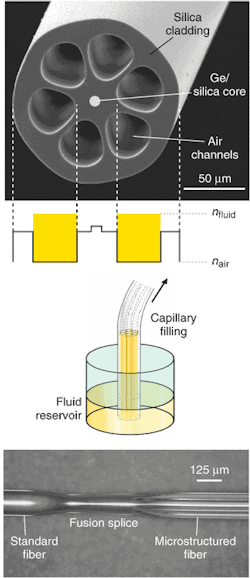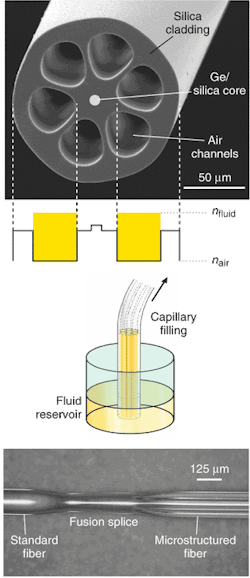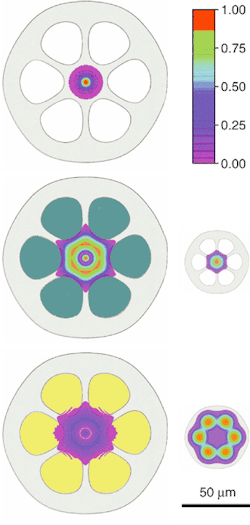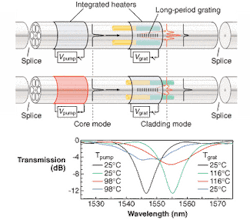Microfluidics adds tunability to optical fiber
Significant improvements in optical networks often come from progress in the materials science and design of optical fiber. Specialized fiber with tailored amounts of chromatic dispersion, for example, was a key enabling technology for high-speed optical transport over long distances.
Recently, new types of fiber have been developed that have interior microchannels oriented along their length.1 These microstructured fibers can produce novel optical characteristics such as photonic bandgap guidance that have the potential to eliminate some of the adverse impacts of nonlinear phenomena in optical transmission. Interior microchannels also provide an opportunity to incorporate materials such as polymers and fluids directly into optical fibers, thereby adjusting the fiber refractive-index profile, and altering in a useful manner the propagation of optical modes.
With a few exceptions fiber today plays a only a passive role in optical communication systems. Making the fiber active and reconfigurable may drive further improvements in networks by increasing their functionality, reducing the number and cost of necessary components, and decreasing the network sensitivity to changing operating conditions.
Recently a new approach has been realized for adding dynamic tunability to optical fiber. This design combines microstructured or "holey" silica fiber with microfluidic plugs that can be tuned and pumped back and forth with actuators formed on the fiber surface. This emerging area is referred to as microfluidic fiber (µFF) optics. These systems are attractive because they can be tuned in a flexible manner over a wide range; they introduce many of the techniques of conventional microfluidic analysis systems into the area of fiberoptics.
These µFF devices allow a broad range of optical functionalities to be built directly into the fiber itself. Examples include devices that provide variable, wavelength-selective attenuation and switchable broadband attenuation.2, 3 These functions are essential for dynamically equalizing the power levels in different channels of wavelength division multiplexed systems, and for other operations that are critical for high-performance optical networks.
The microstructured fiber that was used for a variable wavelength-selective attenuator supports a single mode confined by total internal reflection at the core/cladding interface; this mode does not interact directly with the channels (see Fig. 1). Immersing the cleaved end of this fiber into a fluid reservoir leads to capillary filling of the channels. The resulting microfluidic plugs can be positioned to a desired location along this hybrid fluid-silica fiber, either by applying a vacuum or by allowing the plugs to drain through the channels under the action of gravity.
null
Conventional fusion splicing provides low-loss (0.1 dB) optical coupling of the microstructured fiber to standard single-mode fiber.4 The channel collapse and fusion bonding associated with the splice provides both a hermetic seal and the basis for a robust mechanical joint; it also embeds the fluid plugs between two segments of air-filled channels. Pressurizing one of these two air segments (for example, by increasing its temperature) drives the plugs to a new equilibrium position along the fiber. If the pressurizing mechanism is de-activated (for example, by allowing the heated air to cool), backpressure in the opposing air segment drives the fluid to its original equilibrium position.
This thermal pumping technique is one of several approaches that can be combined with methods to change the intrinsic optical properties of the fluids (such as their refractive index) to control the transmission characteristics of the fiber. To achieve tunability, light in the core is coupled at well-defined spatial positions to modes in which intensity distributions overlap significantly with the fluid-filled channels. Changing the effective index and positions of the fluids alters the propagation of these modes in well-defined and useful ways.
Optical modes and tuning
A long-period grating (LPG) written in the core of the microstructured fiber alters the propagating mode field, and brings it into interaction with fluids in the channels. Specifically, the LPG induces phase-matched coupling of the core mode to a forward-propagating mode that involves significant intensity in the cladding.4 This coupling produces a narrowband-loss feature in the spectrum of transmitted core-mode light. The central position lres of this resonance is governed by the phase-matching condition,
null
where ncore is the effective core mode index, nclad is the effective cladding mode index, and Λ is the period of grating index modulation. The strength of the coupling, which determines the depth of the associated resonance loss, is related to the length of the grating and the magnitude of the associated index modulation. It is also influenced by the nature of the cladding mode.
If the index of the fluid in the channels is below that of silica, then the cladding mode is strictly guided by total internal reflection. In this case, the mode is confined to the central region of the fiber bounded by the interface between the silica and the microfluidic channels. In an LP02 cladding mode in a microstructured fiber in which channels are filled with a liquid having nfluid = 1.3 (see Fig. 2). Because the evanescent part of this mode overlaps with the channels, the index of the fluid influences nclad. Tuning nfluid therefore changes the resonance position λres.
If nfluid > nsilica, then the cladding mode is no longer confined by total internal reflection, and instead experiences increased loss as it propagates through the fiber. A significant reduction in integrated intensity is evident in the intensity profile for an LP02 cladding mode after propagating 1 cm down a microstructured fiber in which channels are filled with liquid having nfluid = 1.8, compared to the fiber filled with liquid of refractive index nfluid = 1.3 (see Fig. 2). This reduction is due to light loss into the high-index channels. For these high-index filling cases, in which the cladding mode is leaky instead of strictly guided, the LPG-mediated core-to-cladding mode coupling is inhibited. Adjusting the degree to which a high-index-fluid plug extends over the grating region therefore continuously tunes the strength of the LPG-generated resonance.
null
Dynamically tunable attenuator
A µFF device that provides a wavelength and depth-tunable narrowband filter uses a two-component microfluidic arrangement in a microstructured fiber with an LPG (4 cm long, Λ = 500 µm) written in its core (see Fig. 3). The tuning fluids consist of adjacent segments of low- (n = 1.3; perfluoroether) and high-index (n = 1.7; methylene iodide) microfluidic plugs. Besides refractive indices, other important characteristics of the fluids for this type of device include immiscibility, high boiling points, and low viscosities. The fluids are pulled into the fiber one after another with no intervening air gap, and positioned such that the interface between them lies at the edge of the LPG.
Independent thin-film on-fiber microheaters control the temperature of the grating region ("grating" heater) and the air channels on one side of the dual-fluid plug ("pump" heater).5 The voltage, Vgrat, applied to the grating heater sets the temperature, and therefore the index, nfluid, of the fluid residing in the LPG region. The pump voltage, Vpump, controls the temperature of the sealed air channels, Tpump, beside the dual-fluid plug; thermal expansion of this air pumps the plug, increasing the overlap of the high-index fluid with the fiber grating. In this manner, Vgrat and Vpump control the LPG resonance wavelength and strength, respectively, in a nearly independent fashion.
FIGURE 3. To tune a µFF tunable attenuator, a voltage applied to the "pump" heater causes the high-index fluid to overlap with the long-period grating, reducing the effective grating length (top). A second integrated "grating" microheater adjusts the temperature, Tgrat, and therefore the index, of fluid that resides in the grating region. Transmission spectra (bottom) show the capability of a dual-fluid µFF device to independently adjust LPG resonance position (via Vgrat) and depth (via Vpump); arrows indicate a cycle of steps through various pump and grating heater temperatures.
A reversible and independent adjustment of grating resonance depth and wavelength is achievable with the dual-fluid microstructured fiber system (see Fig. 3). The tunability in the filter wavelength (across 12 nm) and attenuation strength (12 to 15 dB) in this µFF device are competitive with dynamic gain equalizers that use planar waveguides, liquid crystals and microelectromechanical systems. The ability to achieve this tuning directly within the fiber represents a significant advantage. Furthermore, the small dimensions of the fiber microchannels preserve laminar flow at fluid velocities that are high enough to support millisecond-switching times.
Microfluidics-based fiberoptic technology is appealing partly because it combines the low loss, mechanical robustness, and low cost of conventional fiber with tuning capabilities of bulk optics, microelectromechanical systems, or planar waveguide devices. The tuning range, operating voltages, power consumption, switching times, polarization insensitivity, and nonmechanical operation of µFF devices make them potentially attractive for certain network applications. The successful demonstration of µFF tuning suggests that recent advances in microfluidic optical components and actuation methods developed for planar channel arrays may also be useful for fiberoptics.6 The µFF devices, together with other similar fluidic optical systems, represent promising directions for photonics research
REFERENCES
- J. Hecht, Laser Focus World 37, 207 (2001).
- P. Mach et al., Appl. Phys. Lett. 80, 4294 (2002).
- C. Kerbage et al., Opt. Comm. 204, 179 (2002).
- R. Kashyap, Fiber Bragg Gratings, Academic Press, San Diego, CA (1999).
- J. A. Rogers et al., Opt. Lett. 24, 1328 (1999).
- P. Mach et al, Appl. Phys. Lett. 81, 202 (2002).
PETER MACH, KIRK BALDWIN and JOHN ROGERS are researchers at Bell Laboratories, Lucent Technologies, 600 Mountain Ave., Murray Hill, NJ 07974; e-mail: [email protected]. CHARLES KERBAGE, ROBERT WINDELER, and BENJAMIN EGGLETON are with OFS Laboratories, 600 Mountain Ave., Murray Hill, NJ 07974. MICHELLE DOLINSKI, previously of Bell Laboratories, is now at Harvard University, Cambridge, MA.




